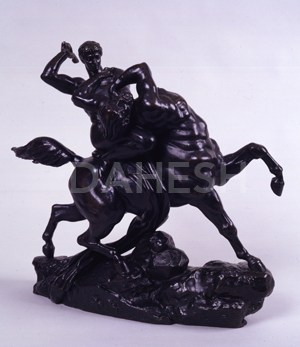Antoine-Louis Barye (French, 1796–1875)
Theseus Combating the Centaur Bianor, modeled ca. 1850
Bronze, 16 1/4 x 6 1/2 x 16 in.
Signed on base bottom left: BARYE
1995.110

Barye is best known for his more Romantic bronzes of animals, but as a student of the Neoclassical sculptor François-Joseph Bosio (1768–1845), he received a thorough grounding in the classical tradition. Ovid recounts the Battle of the Lapiths and the Centaurs in his Metamorphoses. Book XII describes how Theseus, ruler of Athens, helped the king of the Lapiths by violently slaying the centaur Bianor.
Barye exhibited a large plaster of Theseus Combating the Centaur Bianor at the Salon of 1850, after which bronzes in various sizes were cast. Barye must have been aware of the metopes from the Parthenon depicting the Greek legend, but this specific modeling of the death blow delivered by the Greek hero was clearly borrowed from the marble Hercules Slaying a Centaur (1595–1600, Loggia dei Lanzi, Florence) by the Mannerist sculptor Giovanni Bologna (1529–1608). Around 1846–48, Barye had already made an initial sketch of the same. The versions differ substantially, resulting in the less horizontally-oriented composition of this later variant from 1850. The rock formation beneath the horse is slightly higher, the centaur’s upper torso leans further back, and its left front leg is more contracted. The tip of the tail is curled inwards, and the centaur’s hair flows differently than in the earlier sketch. In all, these changes give the later work a greater sense of agony and better express the fierceness of the battle.


